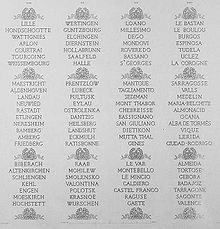Battle of Aldenhoven
| date | October 2, 1794 |
|---|---|
| place | Aldenhoven near Jülich |
| output | French victory |
| Parties to the conflict | |
|---|---|
| Commander | |
|
|
|
| Troop strength | |
| 120,000 | 100,000 |
| losses | |
|
unknown |
unknown |
First Coalition War (1792–1797)
Verdun - Thionville - Valmy - Lille - Mainz (1792) - Jemappes - Namur - Neerektiven - Mainz (1793) - Famars - Valenciennes (1793) - Arlon (1793) - Hondschoote - Meribel - Avesnes-le-Sec - Pirmasens - Toulon - Fontenay-le-Comte - Cholet - Lucon - Trouillas - Menin - Wattignies - Biesingen - Kaiserslautern (1793) - First Battle of Weissenburg (1793) - Second Battle of Weissenburg (1793) - Boulou - Tourcoing - Tournay - 13th Prairial - Fleurus - Vosges - Aldenhoven - San-Lorenzo de la Muga - Genoa - Hyeres - Handschuhsheim - Mainz (1795) - Loano - Montenotte - Millesimo - Dego - Mondovi - Lodi - Borghetto - Castiglione - Mantua - Siegburg - Altenkirchen - Wetzlar - Kircheib - Kehl - Kalteiche - Malsch - Neresheim - Deining - Amberg - Würzburg - Rovereto - Bassano - Limburg - Biberach I - Emmendingen - Schliengen - Arcole - Fall von Kehl - Rivoli (1797) - St. Vincent - Diersheim - Santa Cruz - Neuwied - Camperduin
Two battles of the First Coalition War are referred to as the Battle of Aldenhoven , in which on March 1, 1793 and October 2, 1794 French revolutionary troops and troops from a coalition from Austria and Prussia faced each other near Aldenhoven .
First battle near Aldenhoven
During the First Coalition War, the advance of the French revolutionary troops to the Rhine was initially stopped by the imperial. In the First Battle of Aldenhoven on March 1, 1793, the Austrians won under Field Marshal Coburg , liberated Aachen on the following day and, after the victory at Neerwind at the end of March 1793, pushed the French out of what is now Belgium.
After the French advanced again in 1794, the Austrians - especially after their defeat on June 26 at Fleurus - strongly fortified the right bank of the Rur from Düren to Roermond as a line of defense; they had destroyed the Rurbrücken. At the beginning of October 1794, the 100,000 Austrians and Prussians under General Clairfayt faced 120,000 French soldiers under General Jourdan .
Second battle near Aldenhoven
On the morning of October 2, 1794, the Second Battle of Aldenhoven took place, better known as the Battle of the Rur , in which the French troops were able to cross the river in several places. In the northern section of the front line, in the Heinsberg − Wassenberg area, General Kléber and 18,000 men faced the Austrian troops under General Clairfayt , who fiercely defended themselves. The military road from Maastricht to Neuss crossed the Rur near Ratheim , which is why this point was given special strategic importance. Kléber had a bridge built between Ratheim- Krickelberg and Orsbeck-Luchtenberg, so this was the most hotly contested area.
To the southeast of it, Brigadier General Bernadotte - who later became King of Sweden and Norway -, as the leader of an advance guard , forced his troops to cross the Rur at the "Schanz" near Ratheim. Although many soldiers drowned in the river described as raging, Bernadotte was then able to attack the Austrians on their flank and push back. He personally made a decisive contribution (according to Kléber's battle report) to ensuring that the French army achieved victory. Düren and Jülich fell, Linnich was set on fire by the retreating Austrians.
After spending the night in Wassenberg, Bernadotte pushed further and reached his destination on October 5, 1794: the Rhine near Neuss. The flag that Bernadotte's troops carried when they crossed the Rur near Ratheim was inscribed "Aldenhoven". This is also the name engraved in the Arc de Triomphe in Paris as the site of the victory of the French army . In French sources, this battle is also referred to as that of Jülich (French Juliers ).
On the evening of October 6, 1794, French gunners responded to a cannonade of the imperial garrison of Düsseldorf by bombarding the city, which caused a major fire the following night in which the Düsseldorf residential palace , church and monastery of the Coelestine nuns in Ratinger Strasse, the electoral stables on Mühlenstraße and many town houses burned down and burned down.
literature
- Günter Schneider: 1794 - The French on the way to the Rhine . Helios-Verlag, Aachen 2006, p. 70 f.
- Heribert Heinrichs: Wassenberg. History of a habitat. Mönchengladbach 1987
- Here the Battle of the Rur is shown in detail. The historical data have been compiled from various sources.

